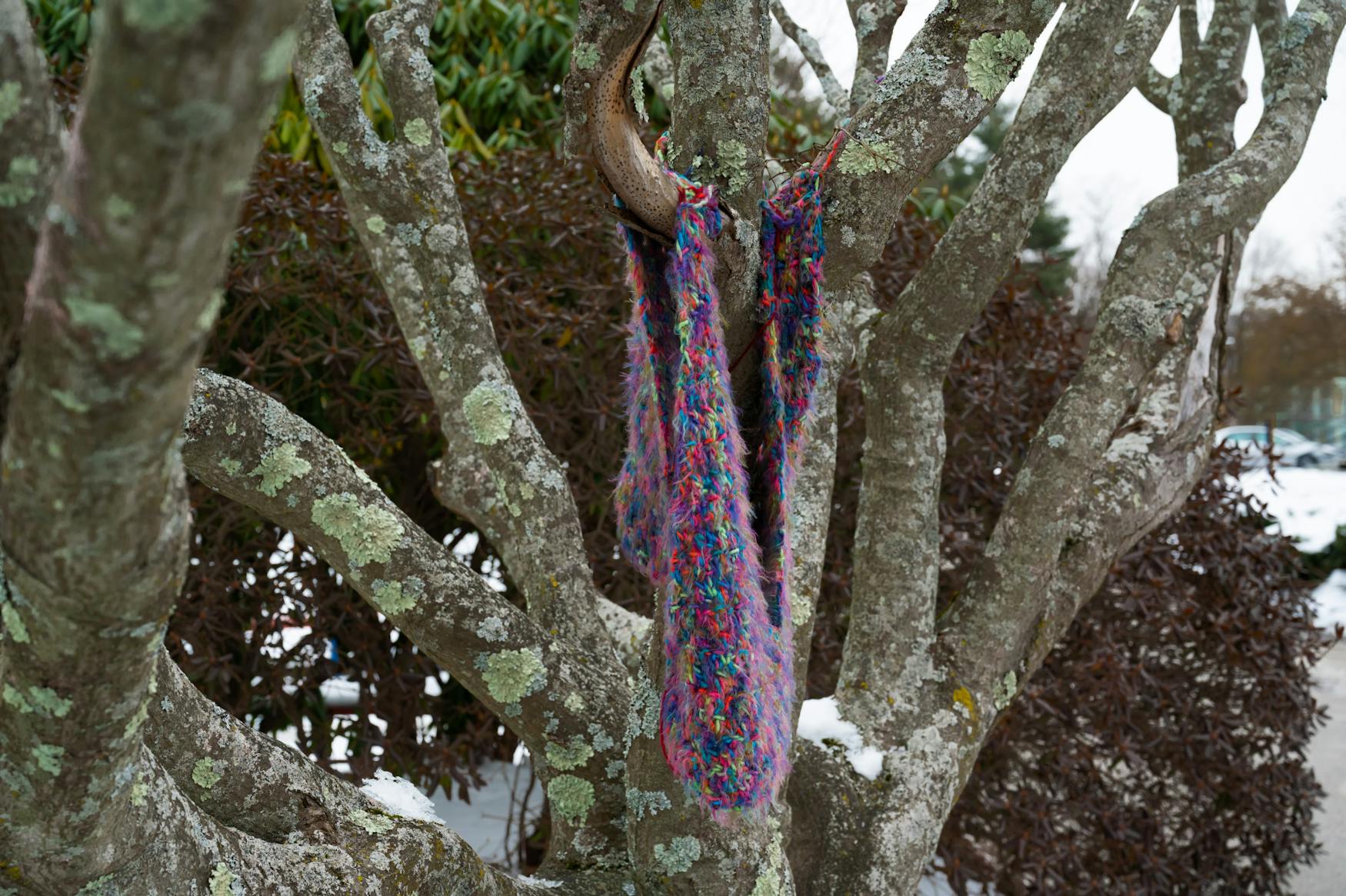Craftivism at Brandeis: Yarn bombing
Creativity can be expressed in many different ways, including making our campus a more soft and cozy place to be.
The tree between Pearlman Hall and the Usdan Student Center has been yarn bombed! The bright colors contrast with the barren branches of a tree in the winter, while the green moss and the green sections of yarn cause a moment of similarity. Over the time that the piece has spent on the tree, it has weathered many of the elements, including snow and rain. The yarn has started to become one with the tree, as it felts to the branches and trunk. The piece has been covered in snow and ice crystals, protecting the tree from the natural elements and keeping it warm during the coldest week of the year.
“Yarn bombing” is a practice that was established and gained popularity in the early 2000s, where artists cover natural and manmade objects in the world with yarn. This can be knitted materials, crochet materials and more! The known origin of this art comes from shop owner Magda Sayeg in Texas, who was tired of the bland commercial landscape that she had to work at every day. She knitted a small cozy for her shop’s door handle, and gained a lot of attention from locals and shop visitors. This led to her work on some bigger projects, including working to establish the yarn bombing crew, a practice that became common for larger projects.
Yarn bombing is a form of social activism. It has been claimed as a feminist movement, as it was a way to get involved with the graffiti scene, which is traditionally seen as a more masculine, male dominated activity. Instead, a very diverse group of primarily feminine identifying people from all corners of the world reclaimed the traditionally feminine arts of knitting and crocheting as a way to give back to and positively impact the community.
In a Jan. 19 email correspondence with The Justice, Ingrid Schorr explained that in a social post she chose to use the wording of “yarn art” instead of “yarn bombing” “out of respect for those affected by violence.” An opinion piece in The Forward reads, “the word ‘bomb’ obliterates the good will, consciousness-raising and well-meaning mischief-making by those who see the great outdoors as their yarn canvas.”

While yarn bombing, or yarn art, is often used just to bring softness and color to a space, it can also be used to spread awareness politically. Many yarn bombers have made statements through this creative form of peaceful protest. This art has been used as an element of the Black Lives Matter movement, spreading awareness regarding domestic violence, and many more similar causes.
This is not the first time that the Brandeis campus has been yarn bombed. On Jan. 19, The Justice sat down with Schorr, the director of Arts Engagement and Communication, to discuss this piece of art. She expressed her love for art across campus, explaining that while many students at Brandeis are inherently creative, they often pick a course of study that leads to a higher-paying career. Moments of art such as this throughout the buildings that house many academic disciplines tie the creative community together and inspire others to think outside of the box.
One of the instances of yarn bombing previously as recalled by Schorr was a small section of trees that had been knitted sweaters to keep them warm. This was a community project with many participants and one student leader. Schorr recalled it with fondness.
Schorr distributes grants every year to students through the Leonard Bernstein Festival of the Creative Arts, and yarn bombing was something that had previously received a grant. The recipient of this grant was interested in the intersection of hard metals and soft wool, ultimately proposing creating some hand made covers for some of the tables and benches outside of Bernstein Marcus. This idea was approved and she set about creating these pieces.
These covers stayed up through much of the spring semester and the following summer, before she decided to take them down due to fading. Yarn bombing can never be a permanent installation, as it is not meant to last forever. Especially those exposed to many natural elements have a relatively short shelf life. That is the beauty of yarn bombing — it is easily removable. Once the artist decides that the art has served its intended purpose, it can be easily taken down without causing any harm to the surrounding environment and surface that it was placed upon.
While not harmful, many knitters and crocheters decide to keep these installations a secret, often sneaking around with handfuls of yarn in the dead of night. The beauty of them is how they appear, often without permission or notice. All of a sudden, something that you walk by every day is just a little bit more beautiful. The tree outside of the Usdan Student Center is one that countless students walk by every day on their way to a psychology lecture or grabbing a coffee from Dunkin. Now that walk is just a little bit more colorful, thanks to the knitted work of art that will one day disappear.



Please note All comments are eligible for publication in The Justice.